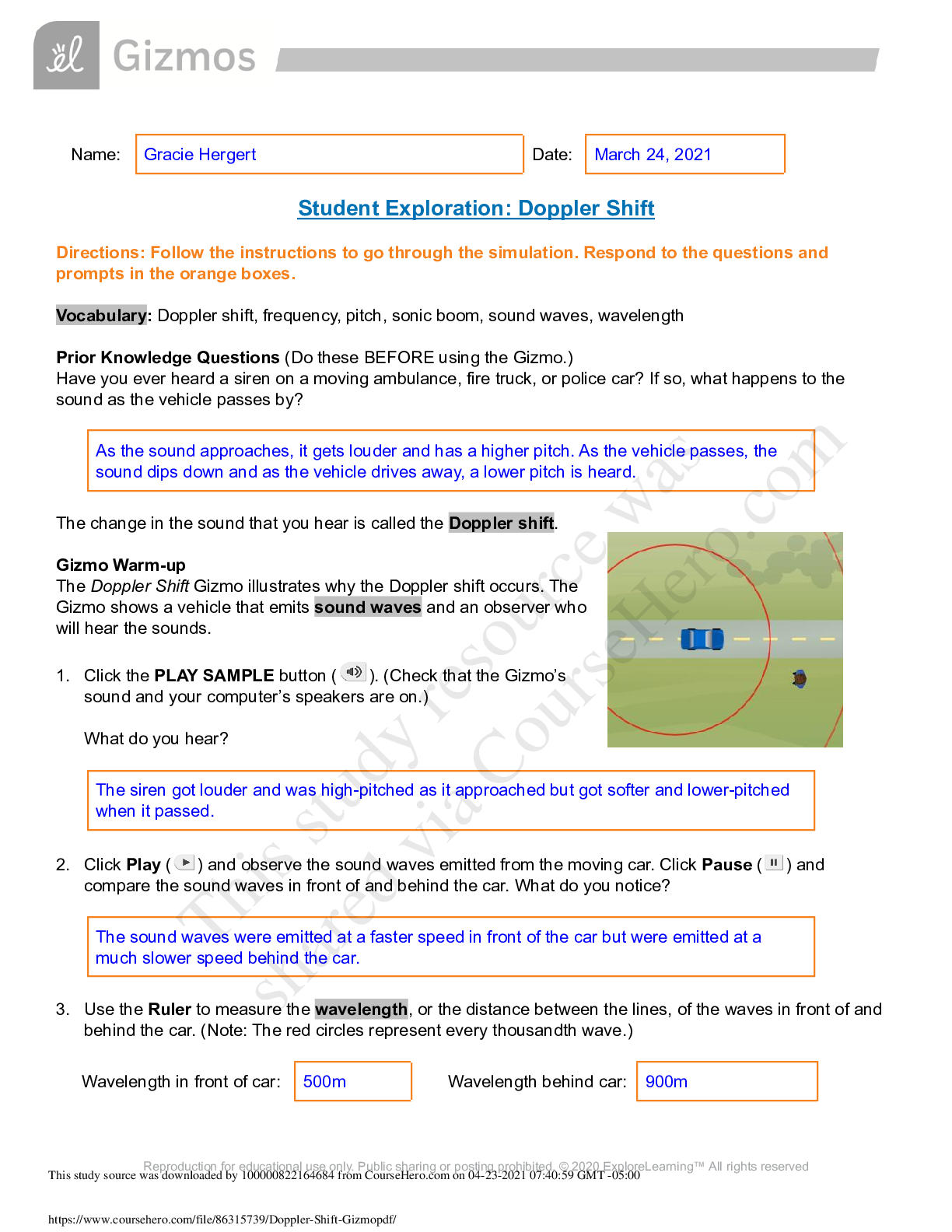
NURS 6660 Midterm Exam - Question & Answer | Walden University
Directions: Follow the instructions to go through the simulation. Respond to the questions and prompts in the orange boxes. Vocabulary: Doppler shift, frequency, pitch, sonic boom, sound waves, wave ... length Prior Knowledge Questions (Do these BEFORE using the Gizmo.) Have you ever heard a siren on a moving ambulance, fire truck, or police car? If so, what happens to the sound as the vehicle passes by? As the sound approaches, it gets louder and has a higher pitch. As the vehicle passes, the sound dips down and as the vehicle drives away, a lower pitch is heard. The change in the sound that you hear is called the Doppler shift. Gizmo Warm-up The Doppler Shift Gizmo illustrates why the Doppler shift occurs. The Gizmo shows a vehicle that emits sound waves and an observer who will hear the sounds. 1. Click the PLAY SAMPLE button ( ). (Check that the Gizmo’s sound and your computer’s speakers are on.) What do you hear? The siren got louder and was high-pitched as it approached but got softer and lower-pitched when it passed. 2. Click Play ( ) and observe the sound waves emitted from the moving car. Click Pause ( ) and compare the sound waves in front of and behind the car. What do you notice? The sound waves were emitted at a faster speed in front of the car but were emitted at a much slower speed behind the car. 3. Use the Ruler to measure the wavelength, or the distance between the lines, of the waves in front of and behind the car. (Note: The red circles represent every thousandth wave.) Wavelength in front of car: 500m Wavelength behind car: 900m Reproduction for educational use only. Public sharing or posting prohibited. © 2020 ExploreLearning™ All rights reserved 4. Why do you think the waves in front of the car have a shorter wavelength than the waves behind the car? The waves in front of the car had a shorter wavelength because the sound waves had a higher frequency and a higher pitch. The waves behind the car had a longer wavelength because the sound waves had a lower frequency and a lower pitch. Activity A: The Doppler shift Get the Gizmo ready: ● Click Reset ( ). ● Check that f source is set to 500 Hz and vsound is set to 340 m/s, close to the actual speed of sound. ● Set v source to 0 m/s. Introduction: The pitch of a sound, or how shrill or deep it is, is related to the frequency of the sound waves. The greater the number of sound waves passing by a point each second is, the higher the frequency and the pitch will be. The unit of frequency is the hertz (Hz). Question: What causes the Doppler shift? 1. Observe: With the car’s velocity (vsource) set to 0 m/s, click Play. Notice the sound waves moving away from the car in all directions. A. Increase the frequency of the sound waves by moving the fsource slider to the right. How does this affect the spacing of the waves? The waves were closer together. When the wavelength of the waves is short, the sound will be high in pitch. B. Now decrease the frequency by moving th [Show More]
Last updated: 3 years ago
Preview 1 out of 5 pages

Buy this document to get the full access instantly
Instant Download Access after purchase
Buy NowInstant download
We Accept:

Can't find what you want? Try our AI powered Search
Connected school, study & course
About the document
Uploaded On
Apr 23, 2021
Number of pages
5
Written in
All
This document has been written for:
Uploaded
Apr 23, 2021
Downloads
0
Views
215
Scholarfriends.com Online Platform by Browsegrades Inc. 651N South Broad St, Middletown DE. United States.
We're available through e-mail, Twitter, Facebook, and live chat.
FAQ
Questions? Leave a message!
Copyright © Scholarfriends · High quality services·